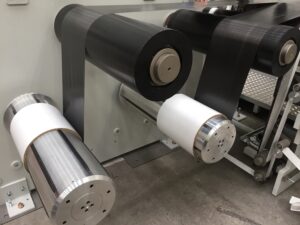In the last decade, Cygnet Texkimp has designed and supplied more than 30 UD and fabric thermoset prepreg lines to the aerospace, automotive and industrial markets.
Our approach to prepreg processing reflects the fundamental engineering principles on which our business is built: our priority is always to protect the health and integrity of the fibre or fabric from package to process, using enhanced web handling technologies to ensure optimum performance and consistency in the resulting materials and parts.
This uncompromising attention to fibre handling and process control runs through our entire portfolio, which includes not only thermoset and thermoplastic prepreg lines but also creels, coating, slitting, filament winding and automated handling and packing technologies.

The challenge
In recent years, we have had a number of discussions with major suppliers of thermoset prepregs to the Tier 1 aerospace industry around designing a solution that would help them meet their ambition for increased production efficiency.
They wanted to overcome time inefficiencies and product wastage caused by the need to stop and restart the prepreg production line during feedstock changeovers.
Frequent and enforced downtime during prepreg production is most commonly linked to the processing of fabric prepregs and occurs when new rolls of fabric need to be spliced (or joined) into the process. Unlike tows for UD prepregs, which are typically wound onto packages at lengths of three to four km, fabrics are wound in much shorter lengths due to their relative thickness. As a result, changeovers are much more frequent.
This creates a significant challenge for the industry. Stopping the machine mid-process can have major implications for efficiency and performance of the final product. When you halt the prepreg line, you subject the prepreg to non-optimal processing conditions in the form of prolonged heat and pressure, which inevitably causes product variations. The impact of this may not be immediately obvious based on visual inspection of the prepreg, but high quality prepreg materials rely on repeatability and consistency, and any interruption to the process jeopardises this. For manufacturers of prepreg materials used to make critical components for high-end applications, such as aeroplane parts, any variation in prepreg quality and consistency that could potentially have an impact on safety is of course unacceptable. As a result, manufacturers are forced to scrap a proportion of the prepreg material that is classed as sub-optimal, along with the associated resins and backing materials, leading to considerable wastage at significant cost.
The act of periodically stopping prepreg production also has implications in terms of the choice of resins a manufacturer has at their disposal. Manufacturers may be forced to choose resins based on their stability and prevented from using short-pot-life resins that might offer preferential features, because of the risk that they will part cure or need to be returned to cold storage during periods of inactivity.

The solution
To address these challenges, we have developed a fabric turret unwind or feed system with auto-splice facility to enable continuous running of the thermoset prepreg and eliminate the need to stop production in order to join new feed stock. The auto-splice solution is designed to reduce waste due to in-process changeovers and enable continuous supply to achieve increased production efficiency and surety of product.
When one unwind position is expiring, another is ready to be fed into the system without the need to stop production. By automating the presentation of the in-feed material, we can maintain optimal and constant line s
peed. The waiting unwind is attached to the process and the expiring material is cut from its roll using the auto-splice module, with no reduction in speed or interruption to production.
Technical considerations
Cutting dry fabrics, particularly those with an open weave, can create bunching or snagging. To address the challenge of achieving a clean crosscut in the material feed, we have developed a unique cutting process incorporating custom knife technology combined with a number of web handling technologies to ensure that the material doesn’t lose tension or form as it is cut from the roll.

